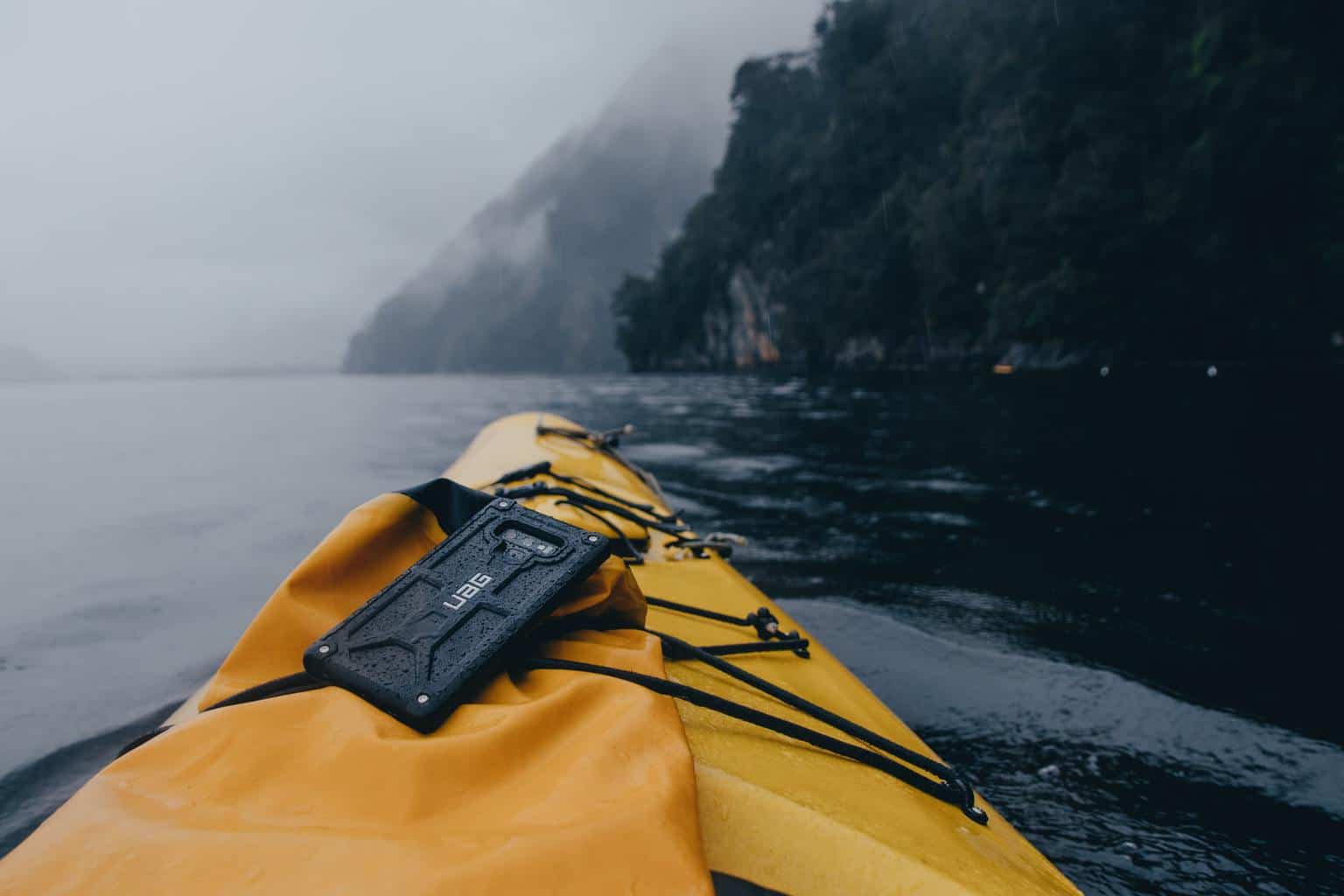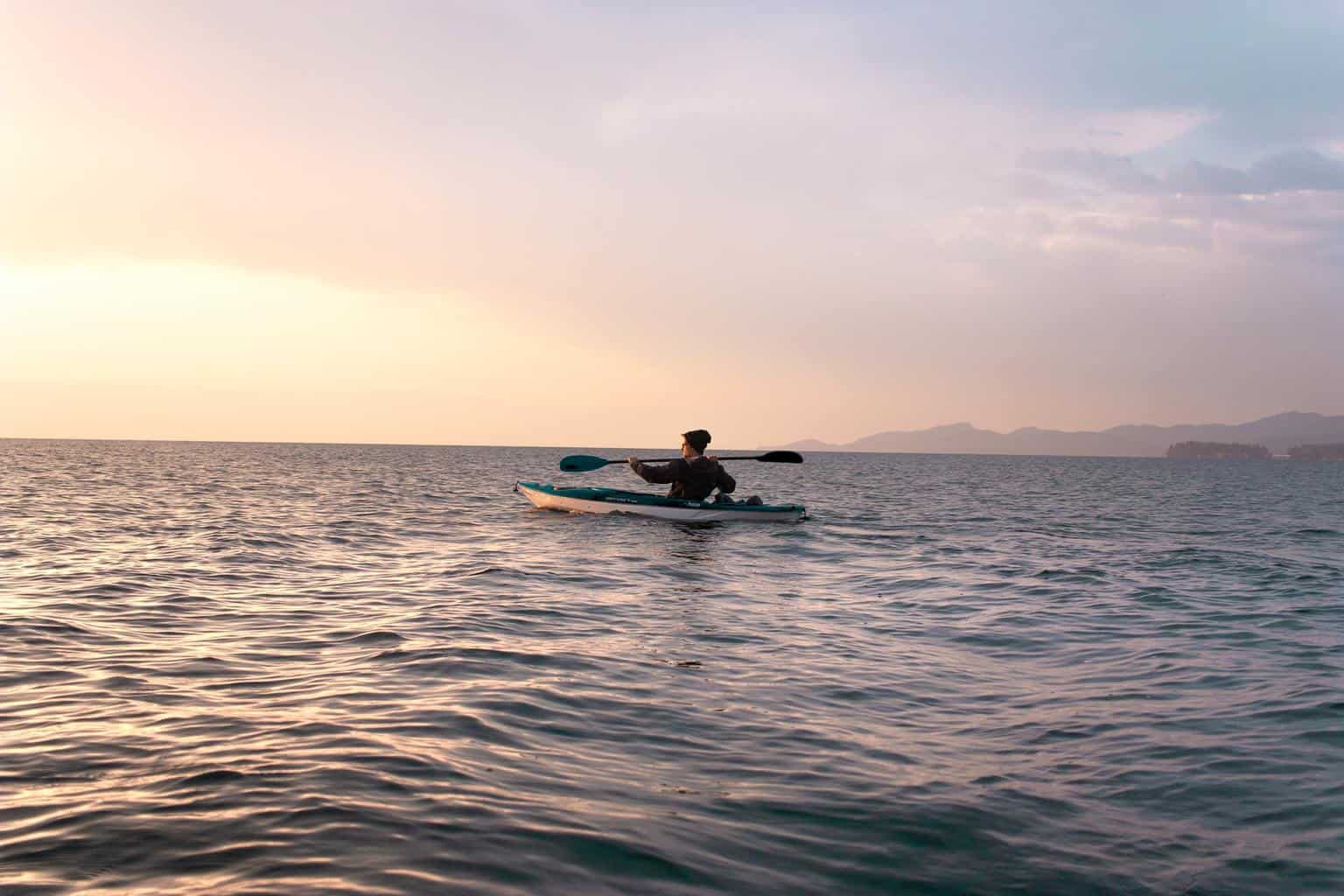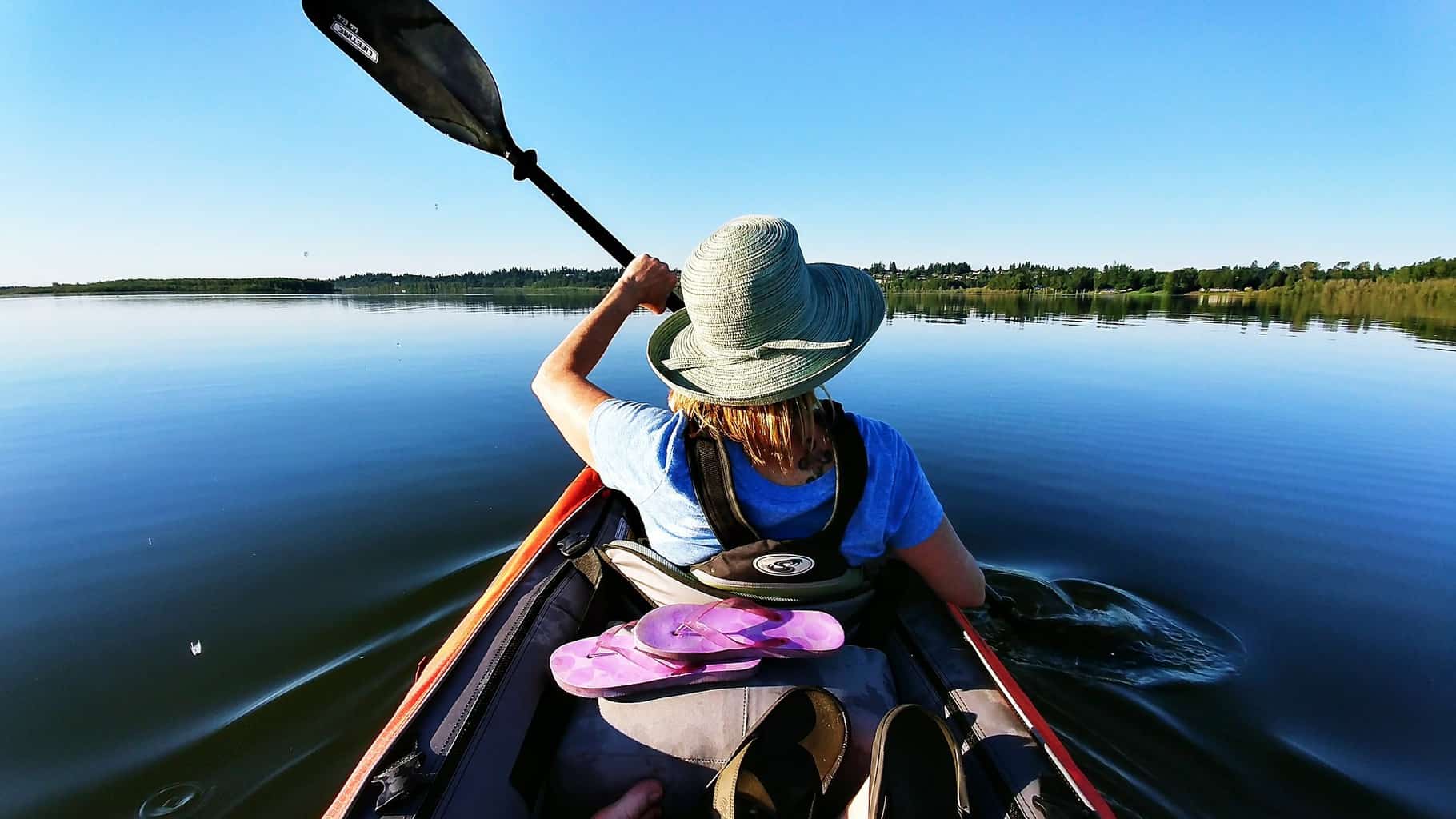Did you know that the average beginner kayaker travels about 3 miles per hour and can hit up to 1,000 strokes per mile?
When you consider that fact, it only makes sense that you might feel some muscle soreness at the end of the day.
Kayaking is an effective workout for your upper back, arms and shoulders.
Once you learn the proper technique, you can expect to benefit from every stroke of your paddle.
With that being said, you do need to remember that paddling a kayak does come with some risk for injuries.
Shoulder strains and sprains are some of the most common injuries among kayakers.
Learning more about why and how they happen gives you an edge for keeping your body in top condition.
- The Anatomy of Your Shoulders
- How to Avoid Shoulder Pain While Kayaking
- What Are Common Types of Shoulder Injuries?
- What About the Long Term Effects of Kayaking Regularly?
- Can I Go Kayaking With a Shoulder Injury?
- How Can I Tell the Difference Between Soreness and a Major Injury?
- Can the Equipment I Use Affect My Shoulders?
- You Might Also Like…
Disclosure: this post contains affiliate links (clearly marked with ), which means we may earn a commission if you buy something through them, at no additional cost to you.
The Anatomy of Your Shoulders
Shoulders are made up of a complex set of muscles, bones and ligaments that all work together to help you move freely.
Your upper arm bone is called the humerus. This bone fits into a round joint within your shoulder blade that is called a glenoid cavity.
Surrounding this joint is a network of muscles and ligaments that is referred to as the rotator cuff.
Injuries to this area tend to occur during times when too much strain is placed upon the bone and muscle structure.
Kayakers can easily injure their shoulders by overextending their arms to the point that the rotator cuff muscles and ligaments get stretched beyond their range of motion.
This usually happens when your arm goes behind your shoulders or when you straighten your arm while applying too much force.
You can also injure the upper part of your shoulder near the clavicle, which is your collarbone. Fortunately, collarbone fractures are rare and likely only to happen if you collide with an object on your route such as a large rock.
How to Avoid Shoulder Pain While Kayaking
The decisions that you make before, during and after your kayaking trip make a big difference in how well your shoulders feel afterwards.
Stretch Before and After Your Trips
Stretching helps to keep the muscles and ligaments in your upper body flexible. There are two different kinds of stretches.
Static stretches are ones that involve holding your body in one position for a specific period of time.
Holding these stretches for 30 seconds to a couple of minutes is one of the best things that you can do to increase your range of motion.
Dynamic stretches involve movement. Shoulder rolls are an example of a dynamic stretch that you can do pre-kayaking to help loosen up your joints.
Plan to spend around five to 10 minutes stretching your upper back, arms and shoulders before you hop in the boat. Then, perform the routine again when you get back on land.
Do Strengthening Exercises
Strong muscles provide stability to the shoulder joint and help to reduce the amount of exertion that you must use to paddle your kayak.
Classic pull-ups and pushups are effective for working all of the muscles in your upper body.
Many kayakers also toss resistance bands in their bag for on-the-go upper body workouts that help to improve their muscle strength.
Make sure to include core strengthening exercises in your workout plans. Planks, crunches and mountain climbers help to keep your core strong and limber so that you can use it to help with paddling.
Use the Proper Technique
Learning the proper way to sit in your kayak and hold your body while paddling makes it easier to avoid accidental injuries.
Beginner kayakers are often introduced to a concept called the paddler’s box. Staying within the imaginary lines of the box helps to prevent shoulder injuries.
The paddler’s box is created by picturing lines that run from where your hands rest on the paddles in front of you and up to your shoulders.
A simple way to stay within the paddler’s box is to remember to never let your hands extend beyond the lines created by your shoulders.
Essentially, you can move your arms up and down within this box, but you want to avoid going outside of the range.
If you need to paddle behind you, turn your torso so that your arm never goes behind your shoulders.
Shoulder injuries also tend to occur when kayakers attempt to prevent or recover from capsizing or rolling their boat.
Practice the proper techniques for bracing. With both high and low bracing, you’ll want to maintain your position within the paddler’s box.
Focus on keeping your paddle in front of you. Reaching your paddle to far off the side of your boat when you slap the water can lead to an overextension injury.
Low braces are also preferable to high ones. In a low brace, your hands are kept below your elbow, which decreases the risk of hurting your shoulders.
Know Your Limits
Many injuries occur when a person pushes themselves too far or winds up in unfavorable water conditions.
Do your due diligence and research the route and water conditions for where you plan to kayak. If you are planning to go sea or whitewater kayaking, then review your techniques for bracing.
Keeping proper techniques for bracing fresh in your mind helps you to avoid panicking and falling out of form if you begin to capsize.
Starting your trip in calmer water can also give you shoulders time to warm up before you begin strenuous paddling.
Even paddling in calm water can put strain on your shoulders if you go too long. Beginners should aim to slowly build up to longer kayaking trips.
Be Careful With Loading and Unloading Your Kayak
Paddling isn’t the only way that you can develop shoulder problems from kayaking. Some injuries occur when kayakers try to lift their kayak onto or off of their vehicle.
If you transport your kayak on the top of your vehicle, then use caution lifting it onto the rack. If possible, have someone help you or use a kayak cart.
Remember to lift with your legs and not with your back. Choosing a lighter weight kayak is also safer when you need to lift it alone.
What Are Common Types of Shoulder Injuries?
The rotator cuff is the part of your shoulder that is most likely to be injured from paddling. Rotator cuff injuries are graded from one to three according to the level of damage that occurs.
A grade one rotator cuff injury involves stretching and microscopic tearing of the muscle and tendon fibers. A grade three strain involves more than 90% of the fibers being torn.
Milder rotator cuff injuries are treated with non-surgical procedures such as applying ice and allowing the muscle to rest. Sometimes, steroid injections or anti-inflammatory medications are used to ease pain and swelling.
Severe rotator cuff injures sometimes require surgery to mend the torn muscle fibers.
Other types of shoulder injuries include the following:
- dislocations
- shoulder impingements
- tendinitis
- bursitis
What About the Long Term Effects of Kayaking Regularly?
Shoulder pain doesn’t always come from a single incident. Paddling is a repetitive motion that can cause damage to your shoulders over time.
Tendinitis is typically short-lived, but it can become chronic if you don’t tend to the symptoms when they occur or adjust your technique as you paddle.
Arthritis is another condition that can develop after many years of kayaking. This condition occurs when the cartilage in your shoulder joint begins to break down or become inflamed.
People who are older than 40 and that kayak frequently are at greater risk for developing shoulder arthritis that is related to kayaking.
Can I Go Kayaking With a Shoulder Injury?
As with any new sport or form of exercise, you’ll want to consult with your doctor before you climb into a kayak with a shoulder injury.
A recent injury may need you to continue to rest and do therapeutic exercises as prescribed until it has healed.
Older injuries typically shouldn’t stop you from being able to go kayaking. Just make sure to start out slow and pay attention to your body’s signals.
Until you know how your shoulder reacts, you might need to plan shorter trips and stay close to the shore.
Choosing calm bodies of water that have a lower risk of you capsizing is another way to prevent re-injuring your shoulder.
Over time, you can gradually add distance and try your hand at choppier water if you prefer bigger adventures and feel like your shoulder can handle it.
How Can I Tell the Difference Between Soreness and a Major Injury?
A mild shoulder injury can still feel extremely painful in the beginning, which can cause you to wonder if you need to seek medical attention.
Muscle soreness typically feels similar to how you feel after lifting weights. This type of pain usually responds to over the counter pain relievers. It should also clear up within a couple of days.
As a general rule, you should seek medical attention for shoulder pain that is accompanied by redness and swelling around the joint.
You should be concerned if you have limited movement or cannot move your shoulder without severe pain.
Pain that wakes you up during the night or causes you to alter your normal movements is a sign that you may have a severe injury.
Shoulder pain that clears up and returns is a sign that you may have trauma that is getting re-injured as you resume your usual activities. This can also be a symptom of repetitive use injuries that need professional treatment.
A severe tear can sometimes generate a snapping or popping sound. If you heard or felt this symptom, then it is possible that you have a tear that warrants a trip to the doctor.
Can the Equipment I Use Affect My Shoulders?
The thought of your favorite activity hurting your shoulders might be upsetting, but there are many things that you can do to prevent shoulder injuries.
In addition to using the proper technique for paddling, you can also look for equipment that reduces strain on your shoulders.
Pick out a kayak that you can sit in comfortably with proper posture. If you are smaller in stature, you might prefer a lighter weight kayak that is easier to push through the water.
The paddles that you choose also alter how much stress is placed upon the shoulder joint.
Start by picking paddles that are the right size for your height and torso size. This prevents your hands from slipping too far out on the shaft.
Bent paddle shafts are an ergonomic option that can increase your comfort and reduce strain on your hands, arms and shoulders.
You can expect to feel some residual soreness after a long day out on the water, but it should never interfere with your overall ability to carry out your normal daily activities.
If you are new to kayaking, take the time to learn how to properly paddle your kayak and brace against capsizing.
Intermediate and advanced kayakers should remember to continue to work on staying in proper form.
With a little caution and post-paddling care, you can enjoy going as far as you want to go in your kayak without worrying about shoulder pain.
You Might Also Like…
-

Kayaking Vs. Rowing: What’s the Difference? (8 Key Differences)
-

When Is It Too Windy for Kayaking? (Crucial Facts You Should Know)
-

When to Go Kayaking? (What Every Kayaker Should Know)
-

Will I Get Wet Kayaking? (Common Reasons & How to Stay Dry)
-

Should I Bring My Phone Kayaking? (7 Good Reasons)
-

What Shoes to Wear Kayaking? (+ the Best Shoes for Your Needs)
-

Can Kayaking Cause Chest Pain? (What Every Kayaker Should Know)
-

Can I Go Kayaking With a New Tattoo? (Facts You Should Know)
-

Can You Go Kayaking On Your Period? (+Practical Tips)
-

Can Kayaking Cause Hemorrhoids? (What Every Kayaker Should Know)
-

Can Kayaking Cause Tennis Elbow? (+8 Simple Tips to Avoid It)
-

Can Kayaking Cause Sciatica? (+7 Tips to Avoid It)












